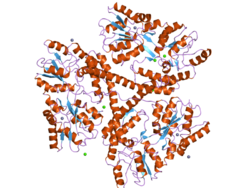Huntington's disease
Classification of the trinucleotide repeat, and resulting disease status, depends on the number of CAG repeats [34] | Repeat count | Classification | Disease status |
|---|
| <26 | Normal | Unaffected |
| 27–35 | Intermediate | Unaffected |
| 36–40 | Reduced penetrance | +/- Affected |
| >40 | Full penetrance | Affected |
Huntington's disease (HD) is caused by a mutated form of the huntingtin gene, where excessive (more than 36) CAG repeats result in formation of an unstable protein. [34] These expanded repeats lead to production of a huntingtin protein that contains an abnormally long polyglutamine tract at the N-terminus. This makes it part of a class of neurodegenerative disorders known as trinucleotide repeat disorders or polyglutamine disorders. The key sequence which is found in Huntington's disease is a trinucleotide repeat expansion of glutamine residues beginning at the 18th amino acid. In unaffected individuals, this contains between 9 and 35 glutamine residues with no adverse effects. [5] However, 36 or more residues produce an erroneous mutant form of Htt, (mHtt). Reduced penetrance is found in counts 36–39. [35]
N-terminal fragments of mHtt have been discovered in Huntington's disease patients. These fragments can be generated by protease enzymes that cut this elongated protein into fragments. Moreover, recent research has identified aberrant splicing to affect the mutant gene products, yielding fragments that coincide with the first exon of the protein. [36] These protein fragments are observed to form abnormal clumps, known as neuronal intranuclear inclusions (NIIs), inside nerve cells, and may attract other, normal proteins into the clumps. The characteristic presence of these clumps in patients was thought to contribute to the development of Huntington disease. [37] However, later research raised questions about the role of the inclusions (clumps) by showing the presence of visible NIIs extended the life of neurons and acted to reduce intracellular mutant huntingtin in neighboring neurons. [38] One confounding factor is that different types of aggregates are now recognised to be formed by the mutant protein, including protein deposits that are too small to be recognised as visible deposits in the above-mentioned studies. [39] The likelihood of neuronal death remains difficult to predict. Likely multiple factors are important, including: (1) the length of CAG repeats in the huntingtin gene and (2) the neuron's exposure to diffuse intracellular mutant huntingtin protein. NIIs (protein clumping) can be helpful as a coping mechanism—and not simply a pathogenic mechanism—to stem neuronal death by decreasing the amount of diffuse huntingtin. [40] This process is particularly likely to occur in the striatum (a part of the brain that coordinates movement) primarily, and the frontal cortex (a part of the brain that controls thinking and emotions). Further, it is possible the pathogenic mechanism lay more with the RNA transcripts and their potential CAG repeats to exhibit RNAi than with the actual huntingtin protein itself. [41]
People with 36 to 40 CAG repeats may or may not develop the signs and symptoms of Huntington disease, while people with more than 40 repeats will develop the disorder during a normal lifetime. When there are more than 60 CAG repeats, the person develops a severe form of HD known as juvenile HD. Therefore, the number of CAG (the sequence coding for the amino acid glutamine) repeats influences the age of onset of the disease. No case of HD has been diagnosed with a count less than 36. [35]
As the altered gene is passed from one generation to the next, the size of the CAG repeat expansion can change; it often increases in size, especially when it is inherited from the father. People with 28 to 35 CAG repeats have not been reported to develop the disorder, but their children are at risk of having the disease if the repeat expansion increases.
In the pathogenesis of the disease, there is further somatic expansion of CAG repeats. It takes decades to reach 80 repeats, then years to reach 150 repeats. Beyond 150, cellular toxicity start to manifest. Over months, the neuron slowly loses its cell identity until cell death pathways are activated. [42]





